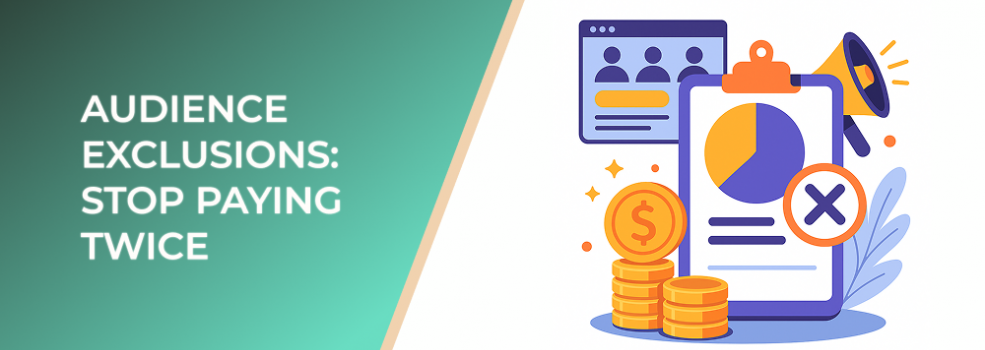Audience exclusions prevent your ads from being delivered to people who are irrelevant, already converted, or already in another stage of your funnel. When you don’t set exclusions, platforms continue showing ads to users who are unlikely to convert again, driving unnecessary spend and lowering campaign performance.
Studies show that 20–40% of budget waste in paid campaigns is caused by overlapping audiences—ads competing against each other and paying repeatedly for the same users. Another analysis of campaign delivery patterns found that up to 28% of impressions in retargeting sets were served to users who had already converted.
Audience exclusions protect your budget from this kind of duplication.
Key Audiences You Should Always Exclude
1. Existing Customers
If the goal is to generate new customers, exclude all existing buyers. This prevents serving acquisition ads to people who have already purchased.
Useful data shows that repeat customers convert 2–3x more often through tailored retention flows than through cold-acquisition ads, so shifting them into separate campaigns yields a higher return.
2. Recent Converters
Exclude people who converted in the last 7–30 days. This reduces unnecessary impressions and eases frequency spikes. Frequent overexposure can inflate CPMs—studies show CPMs can rise by 15–25% when the same users see ads too often.
3. Website Visitors Already in Upper Funnel
If someone viewed a product but did not add to cart, exclude them from lower-funnel retargeting until they take that step. Funnel consistency increases conversion rates by keeping messaging aligned with user intent.
4. Engaged Audiences Already Targeted Elsewhere
Overlapping targeting sets frequently compete in auctions. Removing audience duplication between campaigns helps avoid serving the same user five times in one day from five different ad sets.
Campaigns using structured exclusions consistently report 8–14% lower overall CPA and more stable delivery.
Smart Exclusion Strategies to Boost Efficiency
Use Recency Windows
Exclude users based on how recently they interacted or converted. Short windows (e.g., 3 or 7 days) prevent early-funnel ads from reappearing too soon.
Separate Retention and Acquisition Campaigns
This removes overlap and aligns messaging. Retention audiences often achieve ROAS 40–60% higher than acquisition groups, so mixing them dilutes results.
Maintain a Clear Funnel Structure
Awareness → Consideration → Remarketing → Retention.
Each stage should exclude:
-
All audiences from lower stages
-
All audiences from upper stages currently targeted elsewhere
This keeps messaging consistent and improves frequency distribution.
Update Exclusions Weekly
Behavior shifts quickly. Refreshing lists, pixel events, and engagement-based audiences helps preserve data accuracy and minimize waste.
Example Funnel Exclusion Map
-
Awareness campaigns: Exclude website visitors, video engagers, cart abandoners, and customers.
-
Consideration campaigns: Exclude cart abandoners and customers.
-
Retargeting campaigns: Exclude customers and recent converters.
-
Retention campaigns: Exclude all non-buyers.
This structure prevents overlap at every layer.
The ROI of Clean Exclusions
Brands that systematically use audience exclusions report:
-
18–32% lower wasted spend
-
Up to 25% lower frequency per user
-
Stronger ROAS stability across all campaign objectives
Carefully planned exclusions remove noise, optimize budgets, and make every ad dollar work harder.

